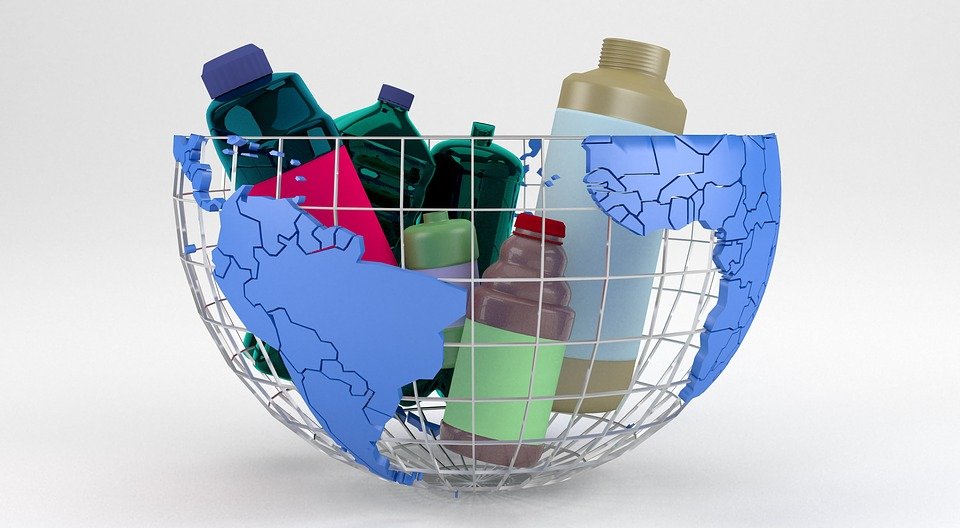
Introduction:
Even the most naïve person should know that almost all man-made product, in the world of plastics, metals, cardboard, and glass is by intent and definition, recyclable. Unfortunately, ninety percent of world plastics go un-recycled. In real life not everything will be recycled or is being recycled because of various causes, though the two main reasons:
- Local Municipalities lack the infrastructure to properly separate materials and recycle them accordingly with homogeneous materials to make new safe products,
- Some do not get recycled because of its nefarious consequences when leaching in the recycling process harmful chemicals into the new products when trying to achieve the so-called “new recyclable materials”. This process also contaminates the water being used to recycle, which then needs to go through a cleaning process in any wastewater facility. In fact, many recycling depots, do not even take certain plastics categorized as “recyclables” because they do not have the machinery and personnel to recycle them and if they do, their recycling costs would skyrocket making them unprofitable.
Having said the above, according to the Canadian Plastic Industry Association (CPIA), not all plastics are recyclable, but most plastics are. The blunt truth is that unfortunately, not every recyclable depot or facility (regardless if it is privately or government-owned) takes them or uses them in their recycling process. CPIA insists that they are “continuously expanding the range of possibilities to include those that aren’t recyclable today.”
Plastic Classification And Codes
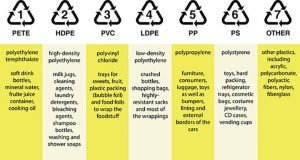
Source: eartheasy.com Many other sites/sources have this exact same table. For a clearer image please visit: https://depositphotos.com/vector-images/resin-identification-code.html?qview=60922897

Recycling codes #1 (hard) and #2 are the most widely accepted.

They are becoming more commonly accepted as technology improves and as the market for these plastics grows. But not all places accept these plastics because they both leak strong chemicals during the recycling process.
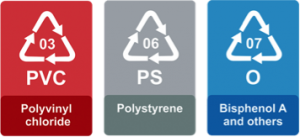
It is difficult to recycle these plastics into other products. Or, in some cases, it is just not economically feasible to do so. These tend to contaminate the recycling stream so they need to be discarded with caution.
Source: greenopedia.com
What Are Plastics?
Plastics are simply “chains of like molecules linked together. These chains are called polymers.” This is why many plastics begin with “poly,” such as polyethylene, polystyrene, and polypropylene.
What are Non–Biodegradable Fossil-Based Polymers?
The term non-biodegradable describes polymers that do not break down to a natural, environmentally safe condition over time by biological processes.
Important Note:
Something to always keep in mind is that bacteria do not attack or eat plastic. Therefore plastics do not tend to be biodegradable unless they are made with new recent technology and materials that are not yet cost-effective, but they are starting to show around more and more. This biodegradability of plastics can only be achieved when microorganisms in the environment break and metabolize the structure of these new biodegradable plastics. This has a positive impact on our landfill and overall environment but we are still far away to make them standard in our various industries.
Is The Canadian Recycling Program In Crisis?
Our recycling program with foreign countries is so inefficient and inaccurate, that thousands of containers are being returned to Canada from Philippines and Malaysia against our tax dollars, along with the serious restrictions imposed by China to the rest of the world (Canada included). Now the questions remain: What are we going to do with those containers full of “recyclable materials”. Easy, we will incinerate them (and push more CO2 into the atmosphere) or we will bury them in our constantly growing landfills. But I guess to some that is only an illusion because our pride does not allow us to see and accept our deficiencies, eh?! Yes, I am being a bit sarcastic, but let us face it, if we do not see and accept our weaknesses and mistakes, we will never implement a positive search for a viable and efficient solution. That by itself is the danger we have to avoid so we can still be an example to other countries that make an effort to emulate us.
Source: CBC News and Globe and Mail (i.e.: https://www.cbc.ca/news/world/we-are-going-to-send-this-back-malaysia-returning-unwanted-canadian-plastic-1.5152274 )
Not too long ago, China decided to close its doors to various types of plastics from all around the world. Since then Canada has been in a difficult position, not knowing what to do with all its plastic, which is currently being accumulated in various landfills across the country.
There was an article published by the Globe and Mail last May 15, 2019, in which one of the main messages are:
“A recent study by Deloitte for Environment and Climate Change Canada shows there is much room for improvement: Only 9 percent of the 3.2 million tonnes of plastic waste generated each year in Canada are recycled. As much as 2.8-million tonnes – the weight of 24 CN Towers – ends up in Canadian landfills.
After 30 years of recycling programs that force residents to collect, wash and fill blue boxes with plastic bottles, bags, and containers, it turns out that in 2016 more than 3.2 million metric tonnes ended up as garbage, according to the summary of a report produced by Deloitte for Environment and Climate Change Canada.
Of that amount, 86 percent went to landfill, 4 percent to incinerators and 1 percent — 29,000 metric tonnes — ended up as litter which can contaminate lakes and oceans. Most of the wasted plastic comes from offices, institutions or industries.”
This is a “come-to-Jesus moment,” says Jo-Anne St. Godard, executive director of the Recycling Council of Ontario. “We’re going to have to shine a light on those materials that we’ve been sort of hoping would get recycled but, really, at the end of the day, aren’t.”
Plastics discarded in Canada – 2016, published by The Globe & Mail (May 15, 2019):
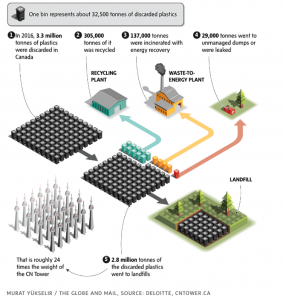 For a clearer image, please visit the main source at https://www.theglobeandmail.com/canada/article-wish-cycling-canadas-recycling-industry-in-crisis-mode/
For a clearer image, please visit the main source at https://www.theglobeandmail.com/canada/article-wish-cycling-canadas-recycling-industry-in-crisis-mode/
It is so bad out there in the world of “recycling”, that recently, there was a strong and alarming statement published in an article written last June 12, 2019, for the Globe & Mail by Ms. Usman Valiante (a well regarded environmental policy analyst with Cardwell Grove Inc.), which says “Our existing recycling policies have failed and Canada needs a new industrial policy on plastic.”

Source: slideshare.net
STARBUCKS – Recycling Program:
During a friendly presentation held for the Word Guild in Kelowna, I was motivated by a non-believer to include this company as an example of our recycling crisis in more detail within this blog. Starbucks has always been an exemplary pioneering company. It has a 30-year legacy to try and reduce the environmental impact around our globe. In “theory”, the typical coffee cup Starbucks uses could be recycled. The only biodegradable item is the cardboard sleeve, while the green stopper, the cup itself and the #5(PP) polypropylene lid are quite difficult to recycle. Why? Because according to Starbucks itself “Starbucks recycling is dependent on the availability of commercial recycling services where our stores are located. Unfortunately, some local communities that offer comprehensive residential recycling may provide minimal or no commercial recycling.” For more information refer to https://www.starbucks.ca/responsibility/environment/recycling
It was not until 2016 that Starbucks came up with a slightly friendlier lid (#5 PP), which is friendlier during the recycling process, but it is not accepted everywhere. Only a few locations providing commercial recycling do. The great majority goes un-recycled and to the landfill.
According to Starbucks: “While our cups can be recycled in many communities today, we are working with local governments and stakeholders to increase their acceptance in recycling systems.” Recycling facilities tend to be capital intensive concerning the selection, separation, and recycling process of the lids and cups, which makes it difficult in the great majority of communities. Regardless, there is always a labour intensive factor all along as well. The truth is that it is so little being recycled, that Starbucks is always trying hard to find friendlier environmental solutions to their cups, lids, and stoppers. In Great Britain, they are testing a new approach where they charge extra for a reusable cup at Gatwick airport (London). Gatwick’s waste management team will collect cups. They will be washed and sterilized according to the airport’s safety standards. They will then be returned to Starbucks ready for customer consumption. Starbucks prefers to implement this option, rather than seeing their lids and cups go un-recycled and into landfills. For more information please refer to https://stories.starbucks.com/emea/stories/2019/starbucks-launch-reusable-cup-trial-at-gatwick-airport/
Dysfunctional System Needs Fixing:
According to an article written by Jeff Lewis and Molly Hayes, environment reporters for the Globe & Mail, “Some Alberta municipalities have nixed select plastic packaging from the blue-bag collection, opting to send it to landfills. In Fort Saskatchewan, just outside Edmonton, fees paid for dropping recyclables at a sorting centre have tripled in the last year. Now, the company that sorts the city’s recyclables wants only those plastics that it can easily sell, such as clear pop bottles and laundry-detergent jugs. In North Glengarry, Ont., meanwhile, residents have been given a new rule: If it crinkles, it’s not recyclable. In other words, no chip bags, multilayer pouches or candy wrappers. “Stretchy” items such as grocery or sandwich bags are out, too.”
Some Plastic Facts:
1. Half of the plastics currently produced are used only once before being discarding (Source: Ateneo De Davao University and National Geographic’s article published December of 2018):
There are two main types of plastic impact, which are:
a. Ocean Plastic Pollution
b. Landfill Plastic Pollution
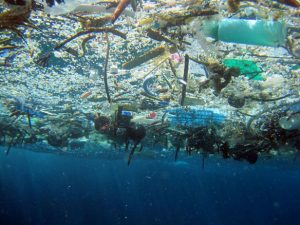
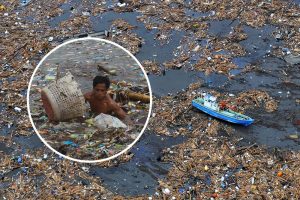
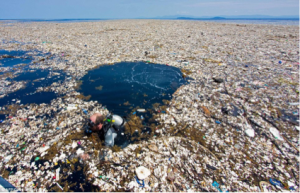
Source: coastalcare.com tekpaksolutions.eu mirror.co.uk
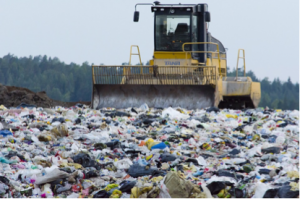
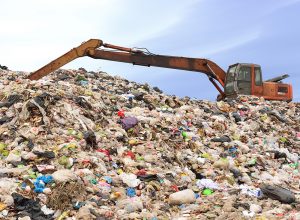
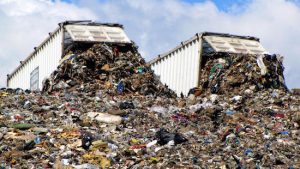
Sources: conserve-every-future.com, bcrc-caribean.com blog.myessentia.com,
Our oceans are being polluted so much by plastics, that after many years some types of plastics have broken down into what is known as Micro Plastics (between 1 & 6 mm in size). These microplastics are being eaten by the lowest species of the ocean food chain known as Phytoplankton (fish larvae). These are then eaten by the next level of the food chain known as Zooplankton (like shrimps and jellyfish). The consumption process goes on through the secondary, tertiary, and quaternary consumers (baitfish, small tuna, sharks, and whales respectively) until reaching human consumption.
2.- According to oceanatlas.org and backed by National Geographic and the Internationalist publications “one-tenth of one percent of the ocean floor has all the coral reefs, which has twenty-five percent of the total ocean species.”
The above is very frightening if we keep in mind that over 50% of coral reefs have disappeared in the past 15 years due to bleaching, oil spills, tourism, overfishing, and plastic pollution. It is feared that by the year 2030, over 90% of coral reefs are expected to disappear if we humans do not take drastic actions to protect them. This could have a devastating effect on our oceans and overall human consumption and would seriously hamper the seafood industry worldwide.
3.- From all plastics ever produced, 90% are still out there in the landfill and the environment. Only about ten percent has been incinerated, producing more greenhouse gases (CO2) as a result.
4.- 18 billion pounds of plastic waste flows into oceans every year.
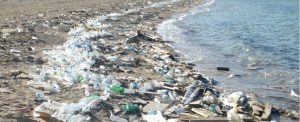
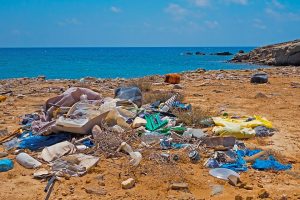
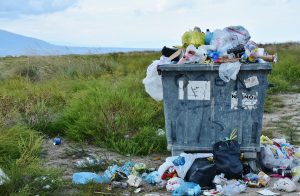
Source: imagefast.com pixabay.com pixabay.com
5.- Close to 50% of all plastics produced are used once and then discarded.
6.- Shoppers in the United States use almost one per resident per day, while shoppers in Denmark use an average of four plastic bags per year.
7.- Nearly half of all plastic ever manufactured has been made since the year 2000
8.- Less than one-fifth of plastic is recycled every year worldwide. China recycles 25% of its plastic, USA 9 %, Europe an average of 30%, and Canada about 9%.
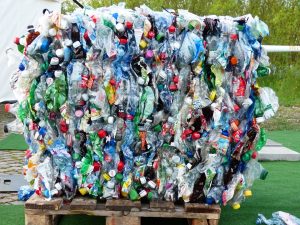
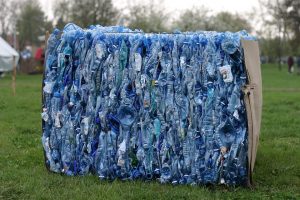
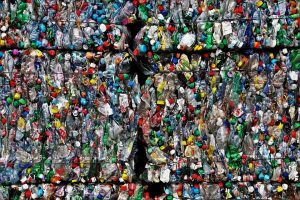
Source: all three images are from www.pixabay.com
9.- Close to 8% of the world’s oil production is used to make plastics. This figure is projected to increase up to 20% by the year 2050 as per the needs of more population increases.
Ocean Waste:
People carelessly dump plastic waste of all types on land, in lakes, and into rivers. Plastics washes into the oceans at a rate of nine million tons per year as per the article on the cover of National Geographic of May 2019, and specifically as per a study done by Jenna Jambeck of the University of Georgia in 2015. At this rate, trash is now visible from beaches, ships, and satellite. Sunlight, winds, and ocean currents eventually break down ocean plastics into very small bits barely visible, referred to as microplastics. These microplastics have had a big negative impact on the fish population, which has been heavily in decline. Added to microplastics, chemical pollution, overfishing, and water acidification and bleaching pushed by climate change are sadly doing their fair share.
By now, everyone should now be aware of the plastic islands being formed in different oceans due to plastic waste and the specific currents that form in the area. Unfortunately, now we are also experiencing serious surface slicks along many coastlines and in between continents and islands, such as the surface slick East of the border of California and Oregon towards the Hawaiian islands. Refer to the image below provided by NASA and published by World Council For Nature.
As per National Geographic, “surface slicks form mostly in coastal regions around the world, wherever currents, tides, or sub-surface waves cause water to converge and concentrate the organic gunk that floats in it. Slicks can be seen by satellite as long, squiggly ribbons that run parallel to coasts.”
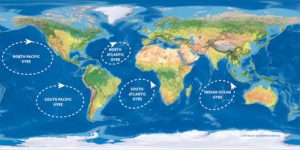
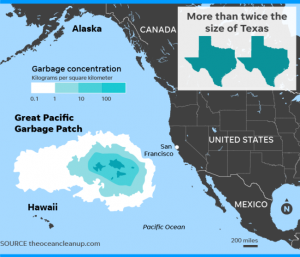
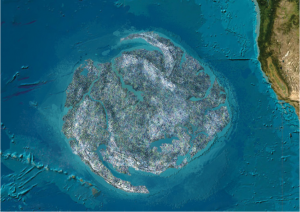
Source: wcfn.org martynstrydom.com NASA.com
Other important facts collected from sources such, as echowatch.com, greenpeace.com and brita.com are:
10.- Coca-Cola alone produced more than 110 billion plastic bottles last year.
11.- Enough plastic is thrown away each year to circle Earth four times.
12.- Plastic accounts for about 10% of all waste we humans produce.
13.- We currently only recover about 5% of all plastics produced worldwide.
14.- US citizens through away 35 billion plastic water bottles every year.
15.- 46 percent of plastics float (EPA 2006) and it can drift for years before eventually concentrating in the ocean gyres (plastic islands or rubbish patches).
16.- The Great Pacific Garbage Patch is located in the North Pacific Gyre off the coast of California and is the largest ocean garbage site in the world.
17.- This floating mass of plastic is twice the size of Texas, with plastic pieces outnumbering sea life six to one.
18.- One million sea birds and 100,000 marine mammals are killed annually from plastic in our oceans, 44 percent of all seabird species.
19.- Twenty-two percent of cetaceans, all sea turtle species and a growing list of fish species have been documented with plastic in or around their bodies.
How Can I Combat The World Of Plastics? What Can I Do?
There are various environmental groups in Canada anybody can join forces with. I am personally a member of two groups known as 350canada.org and ensia.com. The latter is a non-profit media outlet reporting on our changing planet, while the first is focused on stopping fossil fuel extraction and focusing on renewable energy for the future and all human beings. I am also involved in writing blogs on the matter in the subject after having published a trilogy where my second book is entitled “Our Runaway Globe”, which deals with environmental issues and the overall planet’s real condition.
Of course, there are a lot more groups you can choose to join in Canada alone. A site that has a decent number of listed groups or association is goodwork.ca (please visit https://www.goodwork.ca/environmental-groups)
What Can I Do On A Personal Basis?
We can go from very simple to complex alternatives (as per EcoWatch). The more simplistic are:
- Do not accept single-serving packages and only one-use plastics
- Avoid excessive packaging of any type
- Reject the use of disposable plastics and do not be shy to carry your utensils with you (keep them handy in your purse, briefcase, knapsack, or car)
- Reduce everyday plastics and replace them with paper bags or box
- Bring your bags to shopping malls or grocery stores. There are many materials available, being cloth the most common
- Avoid buying bottled water and always have handy your refillable water bottle regardless of the material
- Bring your coffee mug to coffee shops or ask for the re-usable mug for further needs. This will assist our society to avoid the use of various types of lids and plastic-lined cups.
- Avoid buying CDS and DVDS along with any type of jewel cases. Music can now be downloaded online with zero footprint
- If possible, look for biodegradable plastics in your community
- If you MUST use plastic, try using #1(PETE) and #2(HDPE), which can most commonly be recycled and are accepted almost anywhere
- Try to the best of your abilities to avoid using the following plastics: #3 PVC (polyvinyl chloride) #6 PS (polystyrene) and #7 O (others). They are very difficult to recycle, risky, and expensive. Only specialized recycling depots accept them
- Volunteer in your community for river, beach, and lake clean-ups. You would be surprised by the power of many getting together with one common goal help streamline the nation’s disjointed recycling system by starting a small project in your municipality
For more involved and properly planned activities, we can easily start with some of the following alternatives:
- Research in your community where and how can you assist to help achieve this goal
- Demand government funding for recycling and composting infrastructure within your community
- Join groups interested in applying strict restrictions to plastic manufacturers at all industry levels
- Promote what is known as “Circular Economy”, where producers are obliged to be responsible for collecting and recycling plastics (or reusing), displacing the need for new plastics
Questions:
- Did you know that Canada leads the developed world in per capita production of garbage producer? Refer to link: https://www.canadiangeographic.ca/article/canadas-dirty-secret
- Is there enough time to invert the impact and speed in which we are damaging our watersheds (oceans included)?
- Should drastic measures be implemented against the private industries’ packaging and distribution system?
Final Note:
To read more about “SOLID WASTE – OUR HIDDEN TREASURE, proclaims a brochure published by Toronto’s waste management department. ”, click the next link: https://www.furniturelink.co/canadas-dirty-garbage-secret/
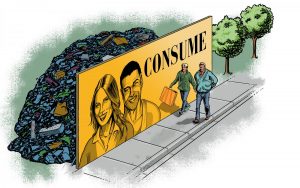
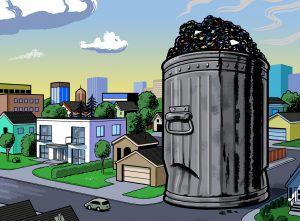
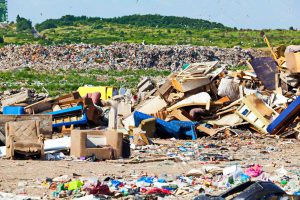
Image Source: consume_guy_parsons-Canadian Geographic
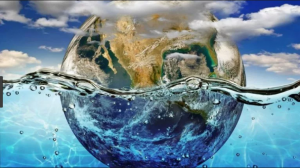
Time to clean up our oceans. Join a group and let us work together for a good common cause.
